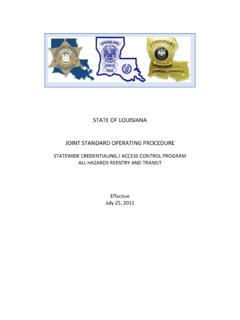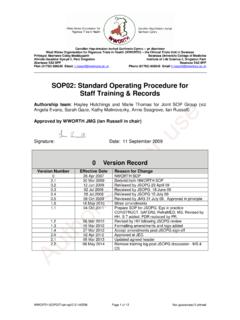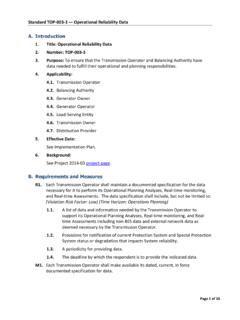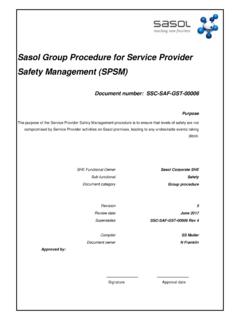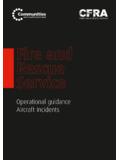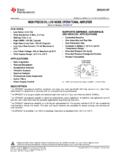Transcription of HID Inspection Guide Offshore
1 HID Inspection Guide Offshore Inspection of operational Risk Assessments Contents Summary Introduction Action Background Appendix 1: Inspection Guidance Appendix 2: Performance assessment Summary This guidance outlines an approach to the Inspection of dutyholder s operational Risk Assessment (ORA) or analogous systems. Similar systems to ORAs include Safety Critical Risk Assessment (SCRA), Safety Critical Element Impairment Risk Assessment (SCEIRA), Safety Critical Element Failure (SCEF) and Deviation Control Risk Assessment (DCRA). Temporary management of change procedures may also be used in such situations.
2 Some dutyholders may operate separate systems for impaired safety critical elements and other defects. For simplicity the term ORA is used in this document to encompass all of these systems. ORA systems may also be used for matters that are not safety related for business or environmental risks: however, HSE inspections should target safety risk issues. It should also be noted that dutyholders may also seek to assess the impact on overall risk either as part of the primary ORA system or by separate means through some other cumulative risk process. Introduction Dutyholder risk management procedures should include arrangements for identifying and assessing the implications of any impairment of safety critical elements and other abnormal situations which affect major accident hazard control systems.
3 The effectiveness of such systems is a key component of risk control in that the system will be used as part of the process in deciding whether affected plant or equipment may remain in use and, at the extreme level, whether an installation, or parts thereof, may continue in operation. An ineffective system may allow significant shortcomings to be allowed to persist, erroneous conclusions to be reached or reinforce the results of non evidence based decision making. This guidance is aimed at promoting an effective approach to the Inspection of such systems. Page 1 of 8 Action The aim of this Inspection Guide (IG) is to provide information and guidance to Offshore inspectors to support the delivery of consistent and effective Offshore ORA management interventions.
4 It does this by highlighting key areas essential to an effective ORA process, so that these can be covered during inspections, providing a framework for inspectors to judge compliance, assign performance ratings, and decide what enforcement action to take should they find legislative breaches. In doing so, it complements HSE s Enforcement Policy Statement (EPS) and Enforcement Management Model (EMM). Each dutyholder will have their own ORA procedures. For Integrated Safe System of Work (ISSOW), users ORAs may be dealt with fully or partly within the ISSOW system and the procedure may form part of the overall ISSOW procedure.
5 The Inspection of the ORA system should include Inspection of the following elements; a) Does the dutyholder have a system, if so are relevant matters covered by the system(s)? b) Does it include the necessary elements that make it potentially effective? c) Is the system being followed? d) Are the outputs of the system credible? (realistic?) e) How does the dutyholder ensure this? f) What monitoring and audit systems are in place and how effective are these? Success criteria (fundamental requirements) are listed under the Inspection topics (see appendix 2); these cover the key issues that inspectors should consider when carrying-out inspections against each core intervention issue.
6 In some instances, not all of the success criteria will apply so inspectors should make a judgement regarding which of these are relevant in each case. If the relevant success criteria cannot be met, inspectors should assess how serious the consequences of failure to comply could be. This will inform their decision making in terms of the performance ratings that they assign and the enforcement action they take (if any) based on the findings of the Inspection . Inspection of this topic should include both Inspection of the system itself and Inspection of the outputs from the system. In inspecting outputs it may be necessary to have input from the relevant specialist inspectors where there are technical issues beyond the competence of the IMT inspector.
7 Appendix 1 includes a more detailed framework for Inspection . Background Relevant legislation Page 2 of 8 The Management of Health and Safety at Work Regulations 1999, Regulation 3(1) Organisation Targeting Inspections should be carried-out in accordance with ED duty holder intervention plans. Timing Inspectors should undertake ORA inspections as part of the agreed ED Offshore Intervention Plan; when intelligence indicates intervention is necessary, or as part of an investigation following an incident. Resources Resource for the undertaking of ORA interventions will be agreed as part of the ED Offshore Work Plan or by agreement between discipline specialist team-leaders and Inspection management team-leaders, as appropriate.
8 Recording & Reporting The duty holder performance ratings should be entered on the Inspection Rating Form (IRF) tab of the relevant installation Intervention Plan Service Order. Findings should be recorded in the normal post Inspection report and letter. Further References Oil&Gas UK - Guidance on the Conduct and Management of operational Risk Assessment for UKCS Offshore Oil and Gas Operations. A framework for monitoring the management of ageing effects on safety critical elements, Energy Institute Research Report, 1st Edition, 2009, The Energy Institute Contacts ED Offshore : Appendices Appendix 1: Inspection guidance Appendix 2: Performance assessment Page 3 of 8 Appendix 1: Inspection Guidance Inspectors should be familiar with the industry guidance in the Oil and Gas UK publication prior to carrying out the Inspection .
9 The Inspection of ORAs should include consideration of the following; Inspection procedure The inspector should become familiar with the dutyholder s procedure and their specific terminology before Inspection Offshore . It is expected that the dutyholder s procedure will contain the following basic components: Details of when the procedure is to be used; A clear definition of what systems or equipment the ORA applies to (including all SCEs), and what degree of shortcoming/ impairment triggers the assessment; Clarity as to how shortcomings or impairments in SCEs should be identified and notified; An Identified rule based systems for foreseeable events ( firepump strategy or action in the event of a TEMPSC being unavailable); A clear methodology to be followed when assessing the risks.
10 A specification of the personnel to be involved including roles and responsibilities; Arrangements for the provision of technical support and the role of this; The level within the organisation at which the assessment can be approved (this may vary depending on the potential consequence or risk); The means by which the ORA status and any associated remedial actions are tracked, monitored and reviewed/ closed out. This may include some priority allocation or risk/ impact categorisation to assist in effective management; There should be a means of determining how individual ORAs may impact on each other to affect the hazard management process and overall risk level.











